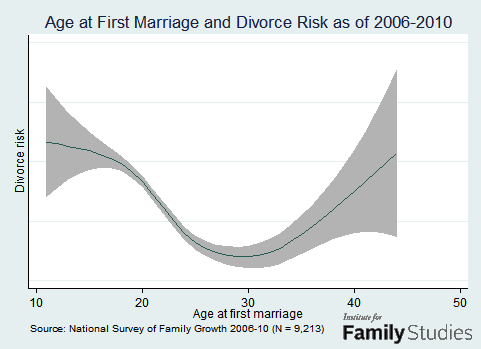When should Goldilocks marry?

Almost everyone has an opinion about the optimum age to marry – usually heavily influenced by their own happy or unfortunate history. But what does the research tell us?
A recent study by Nicholas Wolfinger (USA) and reported in the Institute of Family Studies (here) challenges the common perception that divorce incidence decreases with age – that is, the younger one marries, the more likely it is to end in divorce. Or put another way, older is better.
Comparing data from 2006 and 2010 by the National Survey of Family Growth, Wolfinger reports that the incidence of divorce within five years of first marriage is highest for those who marry before age twenty, declines throughout the twenties by around 11% for each year and then begins to climb again in the thirties.
In other words, there is a clear ‘Goldilocks’ pattern – a preferred time to marry that is not too young and not too old, from mid-twenties to early thirties.

Source: http://family-studies.org/want-to-avoid-divorce-wait-to-get-married-but-not-too-long/
What wisdom can we draw from this?
Although the author did control for several factors including sex, race, family structure of origin, age at the time of the survey, education, religious tradition, religious attendance, and sexual history and size of resident city, he concludes that this relationship between age at first marriage and divorce risk is robust. This makes the results interesting but it’s a bit hard to know what to do with it.
We’re long time advocates of the idea of NOT delaying marriage so this data reinforces our position that there is nothing to be gained by couples delaying marriage simply because they are ‘too young’. Of course, there can be excellent reasons for delaying a wedding, but age is should not be one of them, except if they happen to be under twenty.
Yet when we speak on this topic, lots of twenty-something singles look at us with a pained expression… many would marry if they had someone suitable to do it with. For an individual single in the goldilocks-zone, a willingness to marry can only be fulfilled if he or she can find a willing partner. To a certain extent, the mating process has its own timetable, so giving this information to singles doesn’t really help them much.
On the other hand, this information is very important for those in long term cohabitating relationships and also for well-meaning parents who can often dissuade an enthusiastic couple from pursuing nuptials through the erroneous belief that waiting will make the relationship more divorce resistant.
But here’s the real concern: focussing too much on age, misdirects our attention from more significant factors and from factors that can be influenced. For example, it has long been known that the more sexual partners one has before marriage, the higher the likelihood of later divorce. That’s kind of handy for singles to know because it is something they can make choices about. Similarly, one also has a measure of control over education level and religious practice.
Not with-standing all these considerations, if you really want to swing the marital longevity odds in your favour, the standout choice is marriage education; a simple course of marriage education as a newlywed couple halves your likelihood of divorce in the first three years (read more here), and that’s irrespective of your age at first marriage!




